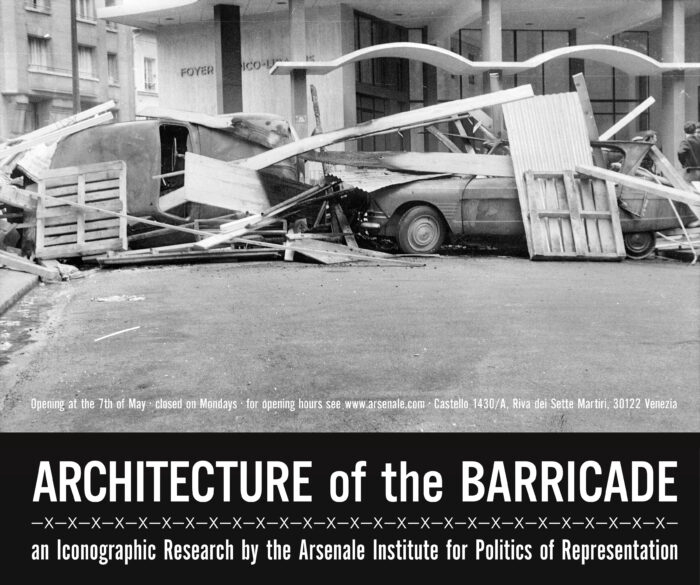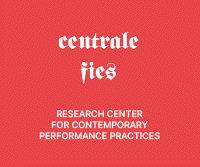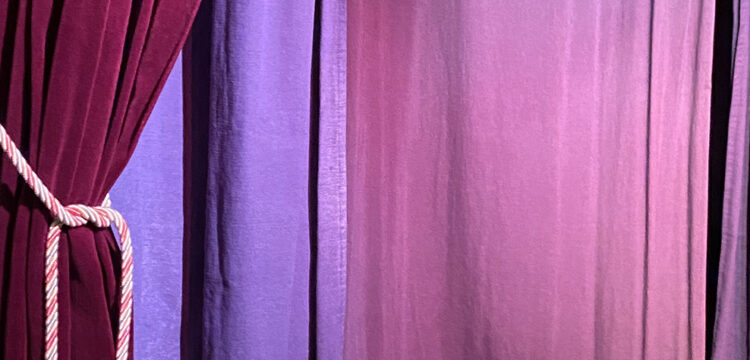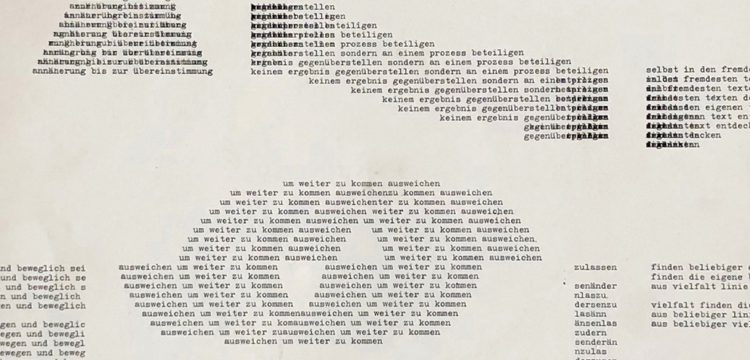Singlossia
I fell in love with Arrigo Lora Totino
The first time I leafed through “Modulo. Rivista di cultura contemporanea n.1” Genoa, 1966 my gaze stumbled upon a work on the cover by Franz Mon and a sentence by Swiss artist Eugen Gomringer. Indeed, he gives a definition of concrete poetry by stating that “it is the bare structure of language: as in modern architecture, the visible form of concrete poetry corresponds to its structure.” To call a magazine “Modulo” is reductive for what is considered an anthology of concrete poetry of which Arrigo Lora Totino is the founder and editor. Despite the fact that it carries the No. 1, there are not subsequent editions and it remains an unicum, a statement of what is the new poetic vision’s concept: a poetry that does not reproduce semantic and aesthetic meaning with words through the usual linear grammatical structure, but rather through play on visual connections and analogies’ links.
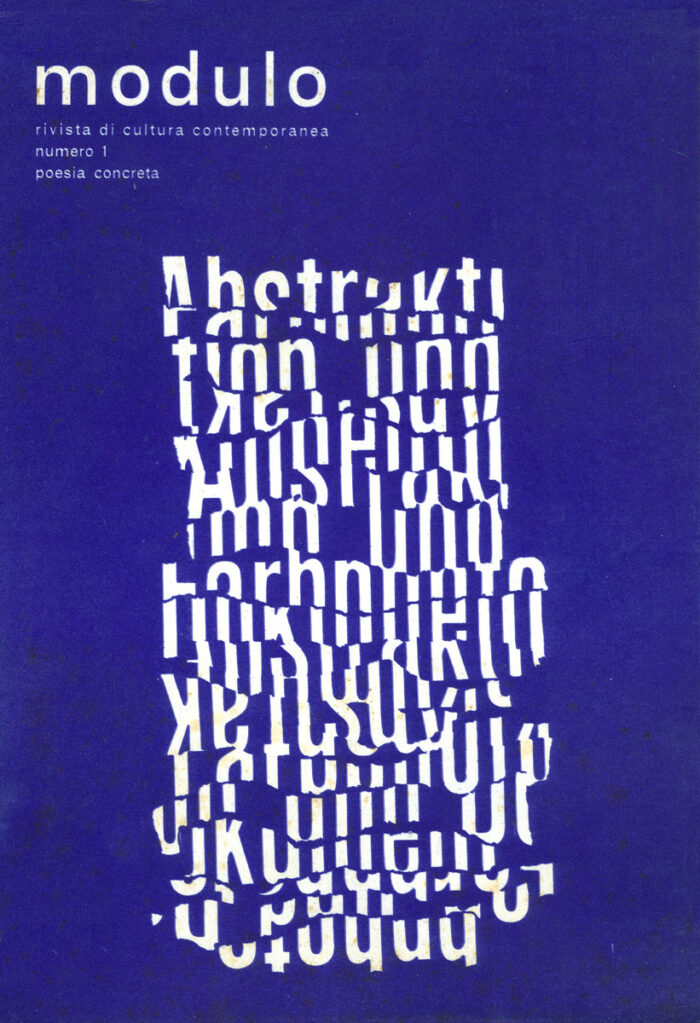
This “Nuova Scrittura” (new writing) involves a mutual influence and expression between meaning and figuration and the Word is no longer used as an intentional means of meaning but becomes a simple tool, like the structure of an architecture or the color in painting. The space within which Arrigo Lora Totino acts would be defined by Adriano Spatola as “Poesia totale”—total poetry: an interest in poetry as a whole and in all its possible declinations or experimentations.
The storytelling of ALT’s work implies dealing with all the stages of poetry’s evolution, its media and its multidisciplinary extension in all the declinations of the New Writing. It also means examining the word’s new role in the visual and performance arts and its perception, which turns out to be synaesthetic and simultaneous.
Arrigo Lora Totino has played a fundamental role in the Italian and international verbal-sound research, never ceasing to swing between words, sound, image, voice and gesture: processes and variations of poetry that see a shared feature in the concept of freedom and unfailing irony, the playful element thus becomes his trademark. Furthermore, the lightness of his practice is not only part of his work but can be found also in his physical characteristics and personality too, stretched to his body, in his gestures and voice. A climax that is reached at the crescendo of the performance, the moment of maximum aesthetic animation of each verse: the poet dressed in a neutral black lycra suit moving in the dynamic space of the Theatre of the Word.
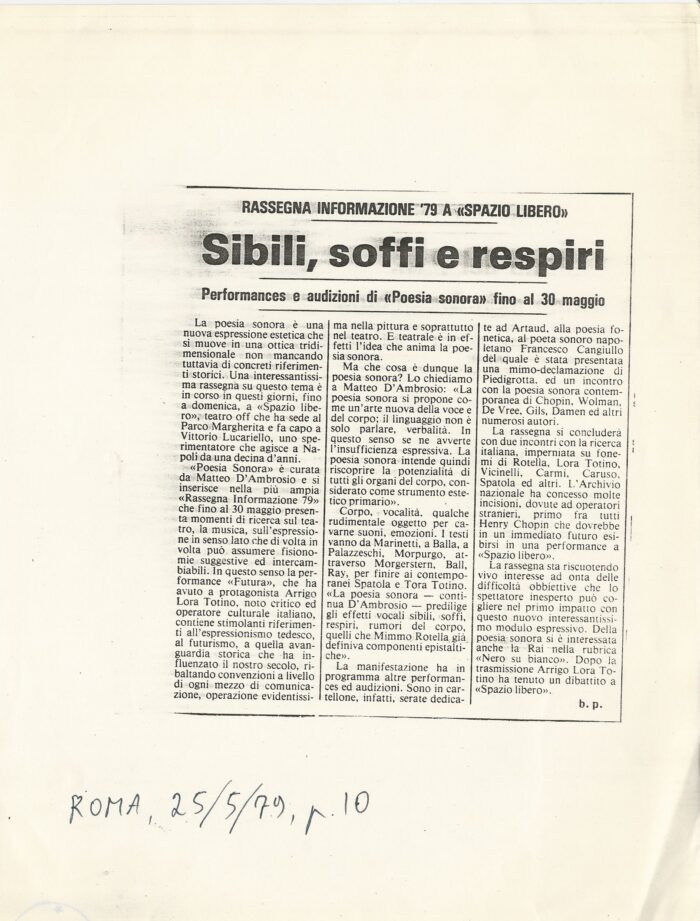
Arrigo Lora Totino was born in 1928 in Turin, stage of a large part of his artistic career. His practice is heterogeneous and involves different media with intense research within the interactivity of different languages. A multifaceted and complex artistic career that began in the field of painting in Turin in the late 1950s, amidst economic and cultural growth. His first approach to the world of art took the form of expressionist painting that Lora Totino practiced in a studio shared with artist Mario Merz. Indeed, some paintings from these years show several affinities with Merz, particularly in the theme concerning the representation of the male face, roughly traced on the thickness of the background. After an initial painting experience, his interest in poetry and the use of words took over. The poetic sensitivity that distinguishes him appears at different times and through different ways. Of utmost importance is the chapter of his life dedicated to experimental literature that sees him as the founder, director and editor of several magazines.

In the 1960s, the publication of magazines by artists themselves became an avenue for self-promotion and the search for one’s own dimension and independence also in the field of communication. Appropriating the tools and techniques of the publishing medium meant in fact not only the possibility of disseminating one’s ideas, but above all it became a way of facilitating international relationships and collaborations. Lora Totino’s publishing experience also stands out due to the enormous network of contacts he managed to develop, which would soon lead him to become one of the international protagonists of visual, concrete and sound poetry. The first magazine he was among the creators of was Antipiugiù, in 1959, in collaboration with some friends including Armando Novero and Aldo Passoni, with four issues produced between 1961 and 1966.
Lora Totino’s skills and abilities had him immediately appointed as the magazine’s editor-in-chief. Antipiugiù represented one of the first magazines of the new-avant-garde, aimed at overcoming the literary situation of the time, identified on the one hand with hermeticism and on the other hand with a more politically-engaged neorealism. The personalities that inspired him were Pound, Eliot and Sartre, as well as other influences from the continuous relations with other poetry magazines, such as Ana Etcetera (directed by Anna and Martino Oberto and Ugo Carrega) and Continuum (the Naples-based magazine of Luciano Caruso and Stelio Maria Martini). Then abroad, there were collaborations with Germany, Switzerland and the Brazilian group Noigandres.
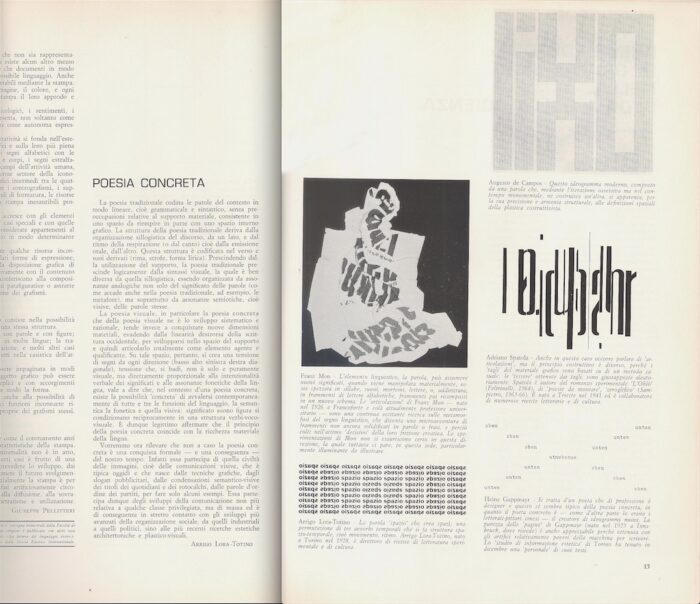
Although his activity as a visual poet achieved European recognition around 1966, as early as 1961 Arrigo Lora Totino decided to further his experimentation, into concrete poetry. In those years his works already circulated in Paris (Galerie Riquelme and Radio Brno) and London. Being in contact with the German, French and American literary avant-garde In 1961, Lora Totino joined the international movement of concrete poetry. After Carlo Belloli’s late futurism, he is the first to introduce concrete poetry in Italy, while internationally Gomringer and the Brazilian group Noigandres (Haroldo and Augusto De Campos and Decio Pignatari) and the French Pierre Garnier are meeting for the first time. The term “concrete” comes from painting, in particular from the title of a magazine published in 1930 in Paris entitled Art Concret.
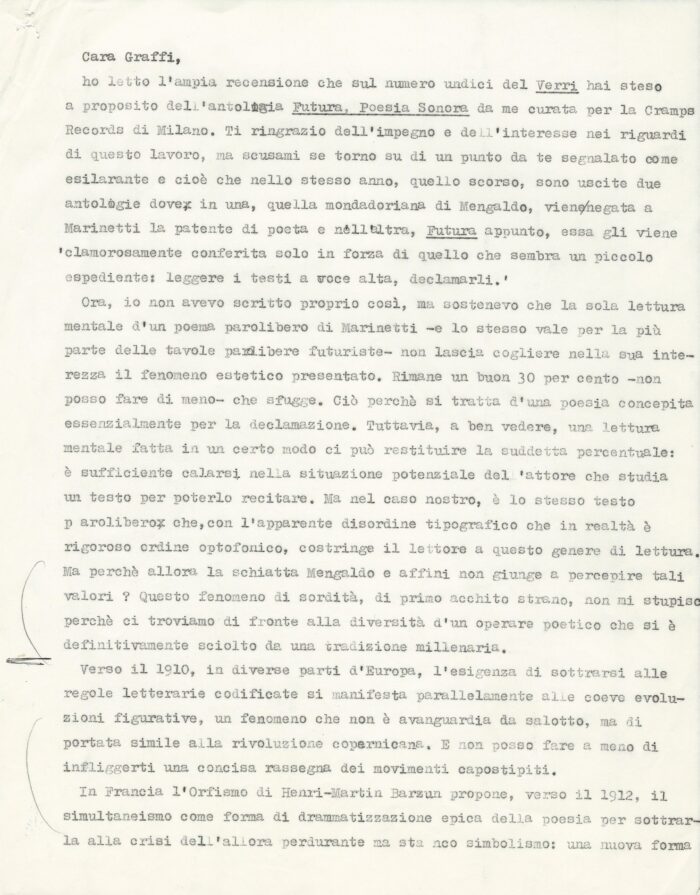
Lora Totino specifically invented a neologism to define his visual and concrete poetry, using the term “verbotetture”, of which he gave the following definition: “it is a matter of associating and integrating type-visual semiotic values with the verbo-phonetic values proper to the word.” The black and white verbotetture represent a substantial part of verbo-visual experiments from the years 1966–1970, a further resumption of the idea of simultaneity already widely addressed by Futurism. Verbotetture are considered a new method of poetic creation, exemplifying the activity of the poet and the new use of the word. Verbotettura as architecture of the word, architecture as machine à habiter, verbotetture as machine à lire. The poet no longer works by semantic fields, by evocation dictated by symbols, but ensures that poetry is reduced to the pure invention of new connections between words. The typographical and signifying medium excludes redundant metaphors, to leave room for the bare word.
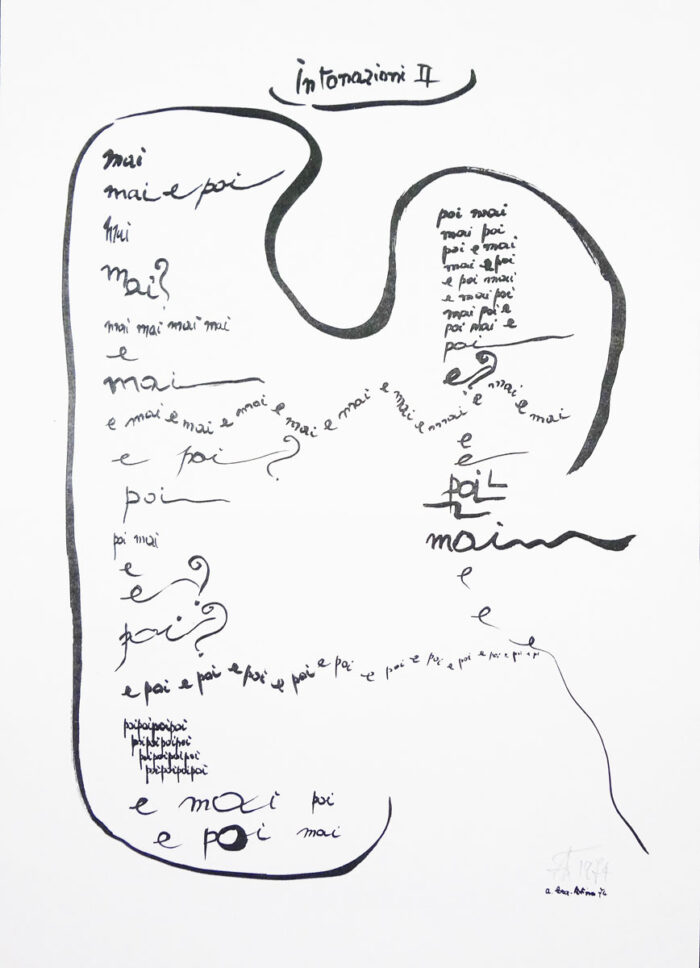
Lora Totino attributes to concrete poetry the idea of being a “literature of alternatives”: examples of this are the various typographic experiments, toward dynamism, brevity, speed and fragmentation. In 1964, he opened the Studio di Informazione Estetica (SIE) in Turin, a center that aimed to develop research into the connections between visual and sound poetry, electronic music and constructivist art. SIE was born out of Lora Totino’s collaboration with artist Alessandro De Alexandris and musician Enore Zaffiri, in a post-informal cultural environment in Turin, and it was presented as a point of conversion among different practices, a sort of multidisciplinary laboratory. The exhibitions they organized highlighted the emergence of a different field of research relating to concrete abstraction (a little-known field) and the desire to act collectively. The type of interdisciplinary research carried out by this group was a unique and isolated experience within Turin’s environment, while resonating in the rest of Italy and in European trends relating to electronic music. The concept of being in a group and acting collectively developed hand in hand with another important principle: experimentalism.
By this, I refer to the varied experimentation of SIE’s project and programme, in which an interdisciplinary dialogue was established involving different practices such as music and visual research. Here, a peculiar characteristic of ALT ‘s personality emerges: he has been able to be a point of connection in the international poetic scene, while being at the center of the relationships between some of the leading personalities within the various avant-garde groups.
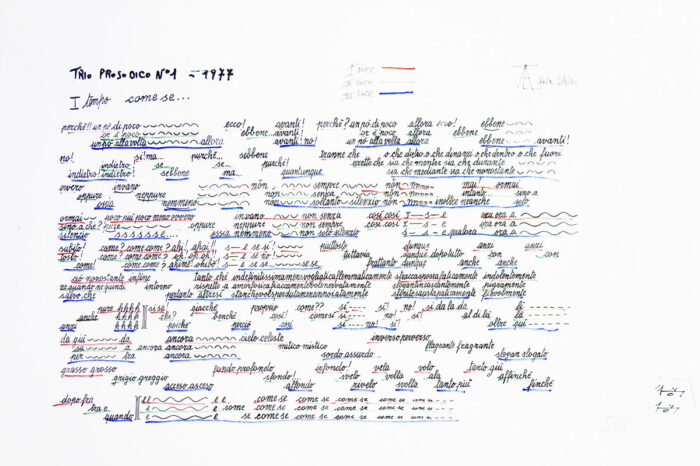
Alliterations, assonances, rhymes and cadences became the main aspects of the poetic discussion. Inter-medial by nature, sound poetry brought to light a new space for sound. From 1965 onwards, this poetic practice affects Lora Torino’s work with Fonemi, an early example of sound practice based on the concept of erasure. The shattering of poetic linearity is carried out through a process that splits the voice recorded on a tape into syllables and phonemes, filtered through an electronic generator. The title Fonemi shows his intentions to get to a structural reduction of the word and the reduction of poetry to its minimal units. The word as it is is no longer as important, but rather a pretext to generate sound, for the sake of beauty of the vocal emission alone—be it a simple breath.
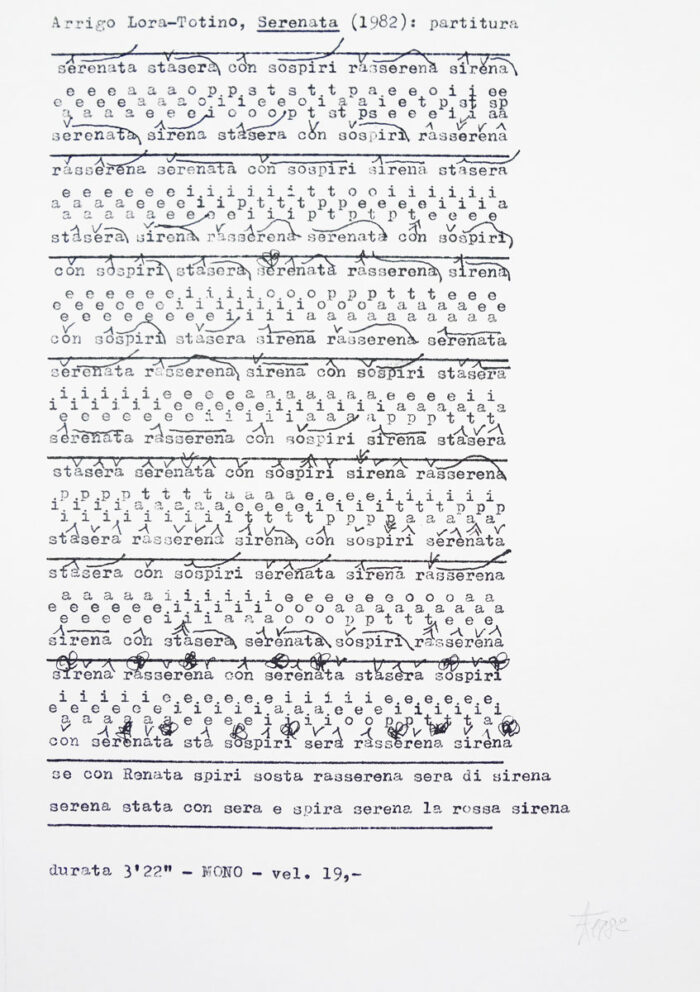
As he did with Verbotetture, Lora Totino coined the neologism Audiotetture to refer to the sounds he reproduced. Around 1970, Lora Totino worked on diction and interpretation of the natural intonations and accents of the voice: thus Intonazioni (1974) and Trii prosodici were born. In 1978 he published a historical-critical anthology of seven vinyl records, Futura, Sound Poetry, with the Milan-based record company Cramps Records. The LPs were accompanied by a critical presentation that covers a period that goes from Futurism to more contemporary experimentations. ALT succeeded in reaching pure vocal sonority and simultaneity, as confirmed by the declaration of poet Julien Blaine, who stated that by analyzing his texts, his readings, and even his posture Lora Totino reached the equation “L’oreille = l’oeil” meaning hearing equals sight. In fact, vocal articulation in all its modulations and the fluidity of the speech is central to all ALT’s experiments. The flowing sonorities of the voice, conceived as a kind of “liquid”, led to the creation of Poesia liquida.
Thanks to the collaboration with Piero Fogliati from Turin, curious acoustic devices were conceived to recreate cabaret atmospheres: they were called Mozzaparole, Rotomegafono, Tritaparole, Idromegafono and Liquimofono, instruments aimed at modeling and deforming the language through body movements. ALT is not only the author, but also the performer of the liquid deformations of his words and stages several performances of poesia e musica Liquida—in particular in 1968 in Fiumalbo, at the Teatro Comunale di Ferrara, and then at the Vismara Gallery in Milan. These performances were executed together with Fogliati: while Lora Totino drowned out words with the Idromegafono, Piero Fogliati produced liquid music with a kind of water organ, the Liquimofono, an instrument he designed and performed. Voice and noise mixed up to become onomatopoeic forms in another performance always with Fogliati: Siderodiafonie created in 1969 at the Galleria Vismara in Milan, in which the duo performed a Sinfonia in a variety of materials such as steel, iron, wood, water, glass and, of course, their own voice. The whole performance seemed to have an apparently random nature, in which iron plates and steel pipes are played with saws and hammers, but instead follows a meticulous score written by Lora Totino.
This modus operandi is taken up again in another project with artist Sergio Cena and musician Roberto Musto, named Orchestra Siderodiafonica. However, the exploration of noise was not limited to the use of metal, but also paper: for instance Carta canta is a project to record all the different sounds that can be produced using different types of paper. All this happens with a sort of small choir of sighing women who together with ALT follow his instructions, inhaling and exhaling according to pre-established rhythms, creating a symphony of breaths. Lora Totino loved to combine voice with body movements through rhythm and expressiveness. Throughout his career, he kept on working on the relation between word, sound and image, exploring every level of communication with extreme curiosity.
The voice and the body represent the two areas of interest that he investigated the most. In 1974, after Poesia Liquida, Lora Totino presented for the first time his Poesia Ginnica, a kind of combination mime-poetry, at the Gruppo Nuove Proposte in Martina Franca. With this new practice, he integrated gestures with words, just as Marinetti had said in 1916: “the futurist should declaim as much with his legs as with his arms.” A dynamic component is added also to Parole in libertà, which combines the harmony of mind and body. The performer’s body becomes the communication tool for perceiving the word. Arrigo Lora Totino deserves recognition for having given body, figuratively and otherwise, to poetry.
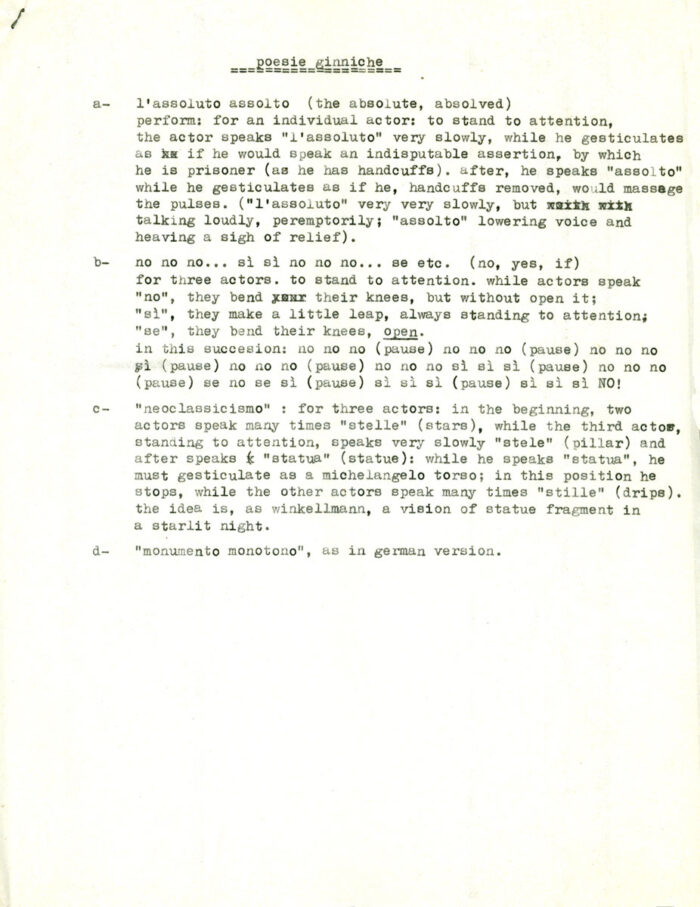
The most famous performances of Poesia ginnica took place in 1976 in Pavia, and in 1977 at Galleria d’Arte Moderna in Bologna during the Settimana Internazionale della Performance. In this last mentioned performance’s catalog, ALT was praised as follows: “wiggling with supreme grace and style and making all the strings vibrate, including the muscles and tendons of his body […] Lora Totino transforms his own body into a perfect musical instrument.” The Poemi ginnici were accompanied by body’s gestures and movements, sometimes hilarious and cabaret-like, to exaggerate the idea of “show”.
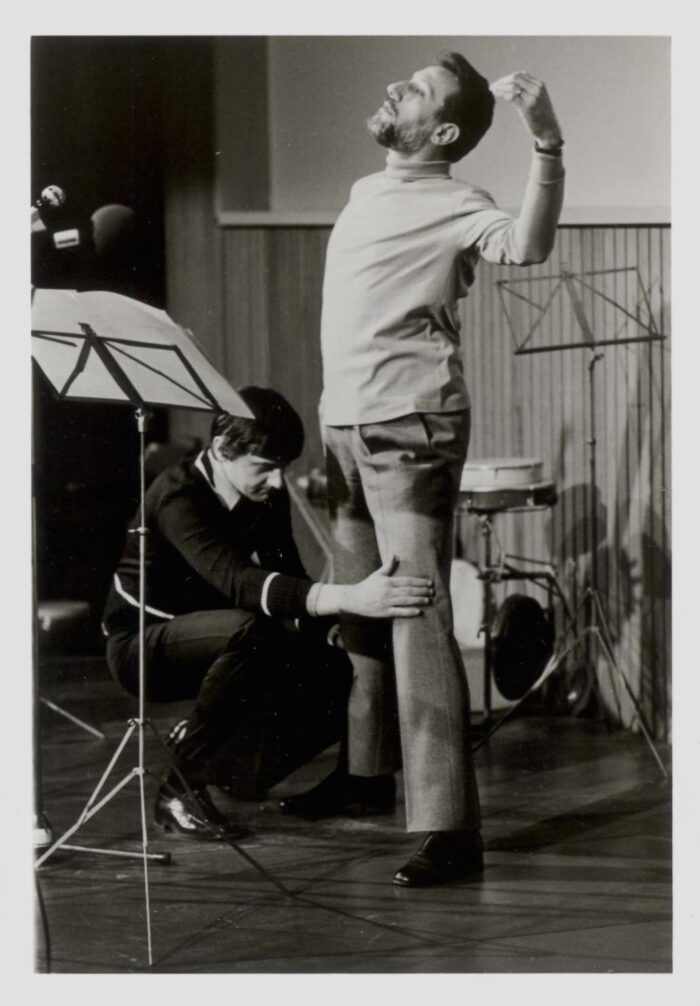
Following the footsteps of Poesia ginnica, Lora Totino continued his stage activity with a series of shows, around two hundred performances across Europe and America, in which the artist declaimed texts from the historical avant-garde. For his mimodeclamazioni ALT was joined by actress and mime from Bologna Valeria Magli and the show, Futura.Poesia Sonora., was organized by the creator of Milano Poesia, Gianni Sassi. The documents of the historical avant-garde became eternal through Lora Totino’s brilliant interpretation, with a stage performance that was never reduced to a banal repetition.
This idea of the revival of the avant-garde dates back to May 1974, when Lora Totino attended the declamation of Bombardamento di Adrianopoli, a piece belonging to the Marinetti’s famous Zang Tumb Tuum (1914), on the occasion of an exhibition of Giacomo Balla’s work at the Galleria Martano in Turin. This experience was followed by an intense study of the phonetic texts of the historical avant-gardes, accompanied by the desire to free them from the silence of a written page and spread them through his own voice.

With this project, Lora Totino proves to be a forerunner of what today is known as “edutainment”, namely the ability to combine education and entertainment in a single performance. By re-presenting a sort of futurism evening with declamations, he succeeded in his intention of being educational through entertainment. These futurist pieces and theoretical texts were a great source of inspiration for his later works as, for example, Il colpo di glottide (1980), a series of thirteen episodes on sound poetry realized for RAI radio; or again, the publication of Storia della poesia sonora (1989) in four audiotapes for the magazine conceived and directed by Adriano Spatola, Baobab- Informazioni fonetiche di poesia, the first audio-magazine on sound poetry in Italy.
Around 1982, two more projects were born out of his collaboration with artist Sergio Cena. The first, Paesaggi Ginnici, performed with two simultaneous voices, and signed with the word pun Lora di Cena da Totino. With a clear reference to Futurist cooking, Pappapoemi were invented, factual dinners in which recipes conceived by the duo were served, along with a sound and body performance.
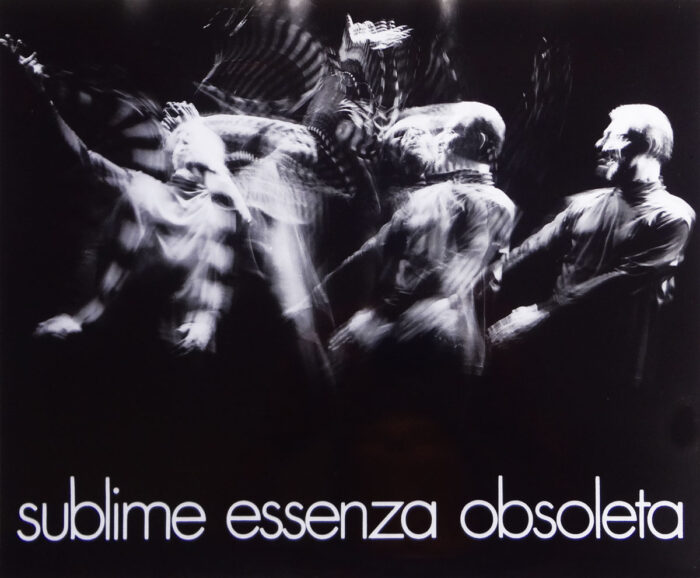
A further evolution of mixture between text and image happened with the photographic medium and print: realized in 1979, the work Fotodinamiche simultanee reconnects us to the Futurist photodynamic concept introduced by Anton Giulio Bragaglia. The matter of the relationship between body, space and movement thus resurfaces in a poetic key, simultaneously examining not only the two-dimensional representation of the body in space but also the sense of gesture, the scenic construction of the image and its rhythm. Bragaglia had written about motion: “[it] exerts a fascination over our senses, the vertiginous lyrical expression of life, the lively invoker of the magnificent dynamic feeling with which the universe incessantly vibrates.” The photographer takes photos while the poet performs his declamations, shots with low light and a black background. The same frame is superimposed with other snapshots to express the idea of the movement carried out by the performer. Added in white, the words of the action that create alliterations and work by analogies, such as palpito palpo amore tutto tatto; slalom slogan slogato; l’assoluto assolto; and so on. Words were added at the bottom as verbal data. A sort of caption, which draws attention to the further evolution between the word itself and the image.
In his multifaceted work, Lora Totino seeks a continuous relationship between different media. His practice was based on a sensory involvement linked to the dynamism of language that has no boundaries and in this sense, becomes complete as the expression becomes synaesthetic. In fact, the word singlossia perfectly explains this concept: it’s impossible to perceive a word and an image or a word and the sound separately.


